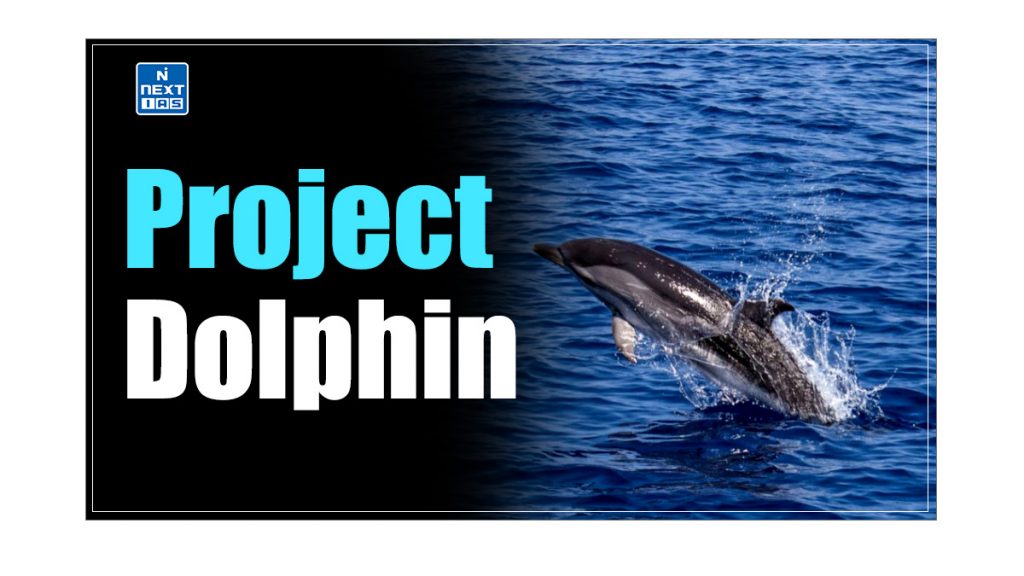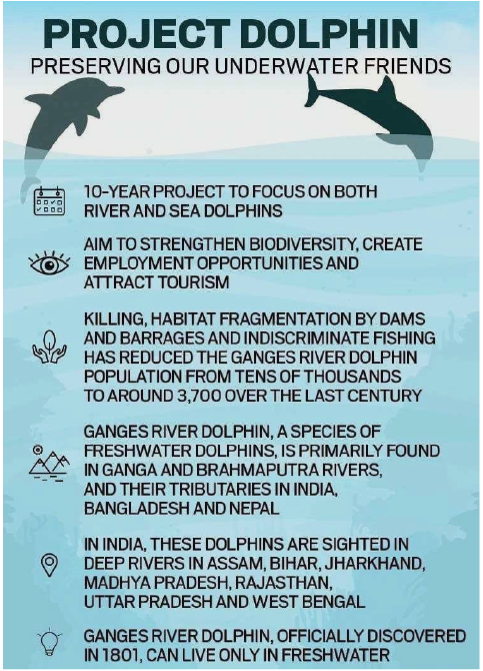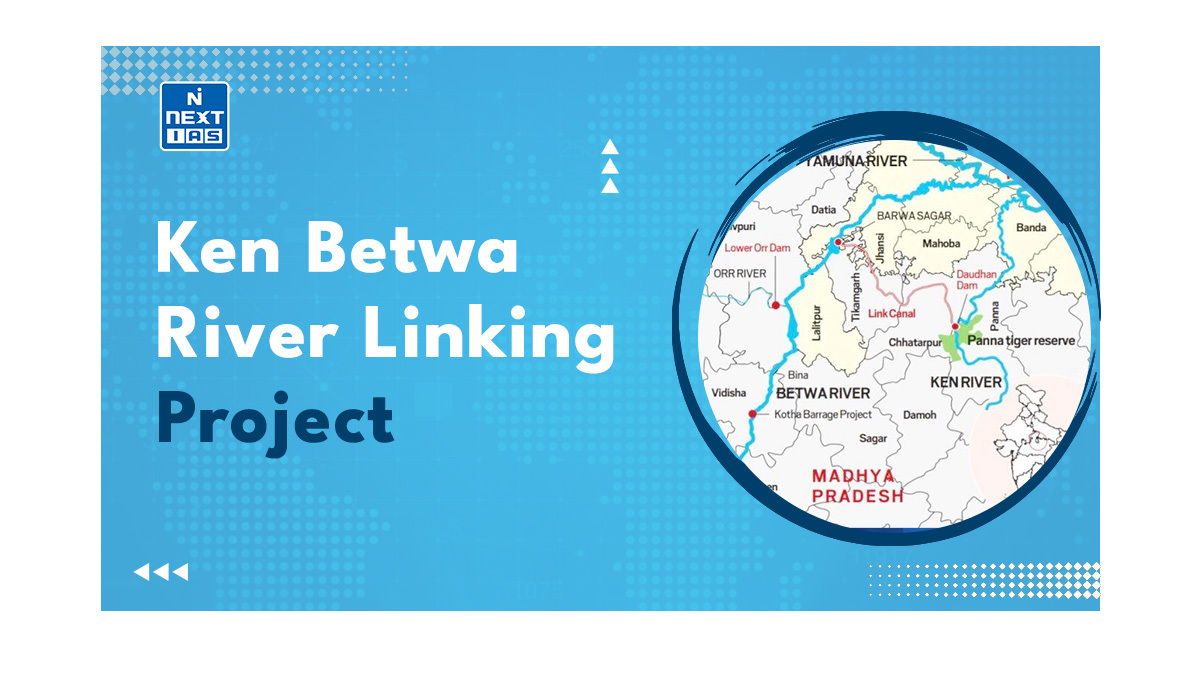
Project Dolphin remains at the forefront of efforts to conserve an iconic aquatic animal species – Dolphins. Ever since its launch, the project has contributed immensely towards saving the endangered Dolphins. This article aims to study in detail the Project Dolphin, its objectives, measures taken, achievements, significance and other related aspects.
About Project Dolphin
- Project Dolphin is a conservation project of the Government of India aimed at conserving riverine and oceanic Dolphins.
- It is a 10-year-long initiative.
- It was announced by the honourable Prime Minister of India, Shri Narendra Modi, on 15th August 2020.
- The nodal ministry for the project is the Ministry of Environment, Forests, and Climate Change.
Objectives of Project Dolphin
- The main objective of the Project is to safeguard India’s diverse Dolphin population, riverine as well as oceanic, by addressing the multifaceted threats they face.
- The project aims to address existing conservation concerns while also empowering stakeholders to participate in dolphin conservation.

About Gangetic River Dolphin
- The Gangetic River Dolphin is a freshwater dolphins species, which is primarily found in the Ganga and Brahmaputra rivers and their tributaries in India, Bangladesh and Nepal.
- In India, these dolphins are found in long deep river reaches in Assam, West Bengal, Bihar, Jharkhand, Madhya Pradesh, Rajasthan, and Uttar Pradesh.
- Gangetic dolphins are essentially blind and hunt by emitting ultrasonic sounds.
- Gangetic Dolphin was declared the national aquatic animal of India in 2009.
- As per official estimates, there are about 3,700 Gangetic River Dolphins in the Indian river systems.
- Gangetic Dolphin has been categorised as endangered on the International Union for the Conservation of Nature Red List.
Threats to Gangetic River Dolphins
The major threats faced by the Gangetic dolphins include:
- Entanglement in fisherman’s nets,
- Rise in salinity level in the water, and
- Frequent movements of boats in the river.
Strategies of Dolphin Project
- The Project aims at the protection and conservation of the Dolphins in the rivers as well as oceans of the country.
- The project involves the conservation of Dolphins as well as aquatic habitats through the use of modern technology, especially in anti-poaching activities and enumeration.
- It will engage the fishermen and other rivers and ocean-dependent populations to improve the livelihood of the local communities.
- The conservation of Dolphin will also envisage activities which will also help in the mitigation of pollution in rivers and the oceans.
Significance of Dolphin Project
- It will help conserve the riverine and oceanic Dolphins.
- Efforts taken under the project will also help reduce river and ocean pollution.
- It will also help develop riverine sites as a centre of attraction for tourism.
- By enabling sustainable fishery and river-based other livelihood options, it will empower the river-dependent population.
- Improved availability of fish and enhancing economies of local communities through sustainable fishery.
Achievements of Dolphin Project
- The Project has made some progress in raising awareness and strengthening conservation efforts.
- The focus on community involvement has led to greater participation from local populations, which is crucial for the long-term success of the project.
Issues with Project Dolphin
While Project Great Indian Bustard has made significant strides, several challenges persist in the conservation of the Great Indian Bustard:
- Not Much Development: The ground situation has remained unchanged, with work yet to begin under the project.
- Lack of Data: Limited information on dolphin populations and their distribution hampers effective conservation planning.
- Enforcement Issues: Implementing strict regulations to protect dolphins from threats requires robust enforcement mechanisms.
- Financial Constraints: Adequate funding is essential for the long-term success of the project.
Suggested Measures to Protect Dolphins
- To overcome the challenges faced by the Project, a multi-pronged approach is necessary.
- Collaborative efforts between government agencies, NGOs, local communities, and researchers are crucial.
- Innovative financing models, such as conservation trusts and impact investments, can be explored to secure sustainable funding.
Conclusion
Project Dolphin is a testament to the country’s commitment to conserving its natural heritage. Though not much progress has been made under this project, it offers huge potential to conserve and protect one of the iconic aquatic animal species of India. The success of this project depends on continued efforts, both at the governmental and community levels, to ensure that this magnificent species does not become extinct.
Frequently Asked Questions (FAQs)
When was Project Dolphin launched in India?
It was launched in India on August 15, 2020 by the honorable Prime Minister Shri Narendra Modi.
What does the Dolphin Project do?
The Dolphin Project aims to protect and conserve the Gangeitc River Dolphin and its aquatic habitats in rivers and oceans of the country.
Which is India’s only dolphin sanctuary?
India’s only dolphin sanctuary is the Vikramshila Gangetic Dolphin Sanctuary, located in the Bhagalpur district of Bihar.
Which sanctuary is famous for Gangetic Dolphin?
Vikramshila Gengetic Dolphin Sanctuary is famous for Gangetic Dolphin.






